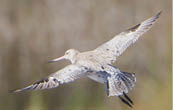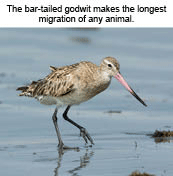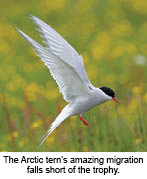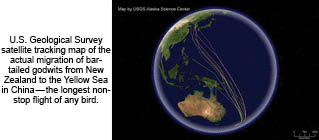

 For many years, we have discussed animals that do incredible migrations. These have included the Arctic tern, whales, caribou, salmon, sea turtles and monarch butterflies. All of these have incredible migratory journeys, but new data has revealed a new long distance champion — the bar-tailed godwit.
For many years, we have discussed animals that do incredible migrations. These have included the Arctic tern, whales, caribou, salmon, sea turtles and monarch butterflies. All of these have incredible migratory journeys, but new data has revealed a new long distance champion — the bar-tailed godwit.
In previous issues, we have discussed the Arctic tern which travels some 12,000 miles twice a year. The bar-tailed godwit travels 18,425 miles, including legs as long as 7,254 miles taking eight days. This bird weighs less than a pound and it cannot swim. The godwit begins its journey in Alaska where it accumulates fat and empties its stomach right before it takes off. When a low pressure system sweeps through the area, the godwit leaves on the trailing edge of the system creating a tail wind that sweeps it southward. It flies for over 200 hours non-stop battling the doldrums and headwinds until it finally lands in New Zealand. The bird has burned off all of its fat and spends several months in New Zealand.
The return trip is truly astounding. The godwit returns to Alaska by way of China. Once again it fattens up and repeats the process, flying 6,500 miles to China's Yellow Sea. There it feeds on the invertebrate mud flats in spring before flying back to Alaska, another 4,625 miles. That makes a total of 18,425 miles. Research has shown amazing factors that make this trip possible. The godwit's stomach shrinks right before take off, minimizing drag, while the flight muscles enlarge. The wind direction is critical and is carefully chosen. The bird is awake for 200 hours or more at a stretch. The navigation is complex since the return flight is so radically different from the original flight.
 ..........
.......... ..........
..........
It would seem that survival for this small bird is threatened by having a genetic program that forces such extreme flight routes. Its food needs could be met in much simpler ways. Potential food sources exist all over the Pacific rim. The benefits this amazing journey brings to widely separated geographic areas and the life forms in those areas are huge. We would suggest a strong testimony to a designer who genetically programmed a small bird to meet a multiplicity of needs in widely separated geographic areas. We can see God's design in the things that he has made, and the godwits are an extreme example of that design. Source: Alaska magazine, October 2013, pages 46.
Picture credits:
http://en.wikipedia.org/wiki/File:Limosa_lapponica_Landing_-_Orielton_Lagoon.jpg
Bar-tailed godwit: © davemontruil. Image from BigStockPhoto.com.
Arctic tern: © AndreAnita. Image from BigStockPhoto.com.
http://en.wikipedia.org/wiki/File:Bar-tailed_Godwit_migration.jpg.
